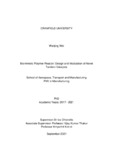JavaScript is disabled for your browser. Some features of this site may not work without it.
| dc.contributor.advisor | Chianella, Iva | |
| dc.contributor.advisor | Thakur, Vijay Kumar | |
| dc.contributor.advisor | Koziol, Krzysztof | |
| dc.contributor.author | Wei, Wenjing | |
| dc.date.accessioned | 2024-04-03T14:45:56Z | |
| dc.date.available | 2024-04-03T14:45:56Z | |
| dc.date.issued | 2021-09 | |
| dc.identifier.uri | https://dspace.lib.cranfield.ac.uk/handle/1826/21133 | |
| dc.description | Thakur, Vijay Kumar - Associate Supervisor Koziol, Krzysztof - Associate Supervisor | en_UK |
| dc.description.abstract | Tandem catalysis can perform multi-step catalytic reactions in one-pot sequentially, which not only improves the efficiency of reactions significantly, but also decreases time, energy and the amounts of reagents needed. However, as there is always more than one active site (catalyst) in tandem reactors, it is critical to separate different sites and ensure each step is conducted individually. Moreover, it is often challenging to control the whole reaction processes due to the complexity of the systems. In this research, several bio-inspired catalytic reactors were proposed and developed to address the two challenges of site separation and smart control of tandem catalysis. First of all, the goal of sites separation has been achieved in this work through an enzyme-inspired molecularly imprinted polymer reactor MIP-Au-NP-BNPC and a core-shell structure catalytic nanoreactor AMPS@AM-Ag. Two molecularly imprinted cavities were created in MIP-Au-NP-BNPC. The different channels of the two catalytic sites in the reactor enabled different catalytic reactions to occur in different regions, resulting in the process of tandem reactions. As a result of the radial distribution of catalytic sites and mass transfer, the core-shell structure of AMPS@AM-Ag enabled the nanoreactor to perform different catalytic processes sequentially. Hence, the nanoreactor demonstrated the ability to conduct tandem catalysis with successful site separation. Then a biomimetic switch was introduced into the reactor to achieve the smart control of the catalytic process. Firstly, a new type of catalytic reactor consisting of a three-layer mussel-inspired polymer, MIP-AgPRS, was developed. The smart switchable layer composed of mussel-inspired self-healing copolymer was prepared between two MIP layers. This middle smart layer was able to react to different temperatures, permitting either simple or tandem reactions by closing and opening the access of the intermediate products. Secondly, a bilayer polymer reactor, DPR, composed of two different temperature-sensitive polymer layers was prepared. The two functional layers were not only able to respond to different specific temperatures, but each also contained different catalytic sites. Because of the two different phase transition processes of the two layers, the polymer reactor demonstrated to be able to perform simple/tandem catalysis in different temperature regions. As a result, this new type of bilayer polymer reactor was capable of achieving smart control of the tandem reactions. Finally, a three-layer switchable polymer reactor, PRS, with two MIP layers and a PNIPAM-PAM switchable layer in the middle was prepared. In an aqueous environment, when the temperature was low (lower than 47 °C), it exhibited an open access (hydrophilic condition), while when the temperature was high (higher than 47 °C), it became closed (hydrophobic condition). Furthermore, a comonomer (AM) was introduced in the middle layer with different ratios to adjust the responsive temperature range, enabling a more comprehensive range of practical uses. Therefore, a fast responsive and stable polymer reactor with self- controlled catalytic property was obtained. By preparing different types of new catalytic reactors, the research carried out here has shown the ability to achieve a smart control of the tandem catalysis while separating the catalytic sites effectively. Therefore, this study has highlighted new solutions to address the challenges present in tandem catalysis and has provided novel inspiration on how to exploit functional polymers while performing complicated catalytic reactions. | en_UK |
| dc.language.iso | en_UK | en_UK |
| dc.publisher | Cranfield University | en_UK |
| dc.rights | © Cranfield University, 2021. All rights reserved. No part of this publication may be reproduced without the written permission of the copyright holder. | en_UK |
| dc.subject | tandem catalysis | en_UK |
| dc.subject | sites separation | en_UK |
| dc.subject | bio-inspired polymer | en_UK |
| dc.subject | smart catalytic reactor | en_UK |
| dc.subject | enzyme-inspired | en_UK |
| dc.subject | core-shell structure | en_UK |
| dc.title | Biomimetic polymer reactor: design and modulation of novel tandem catalysts. | en_UK |
| dc.type | Thesis or dissertation | en_UK |
| dc.type.qualificationlevel | Doctoral | en_UK |
| dc.type.qualificationname | PhD | en_UK |
| dc.publisher.department | SATM | en_UK |
| dc.description.coursename | PhD in Manufacturing | en_UK |
